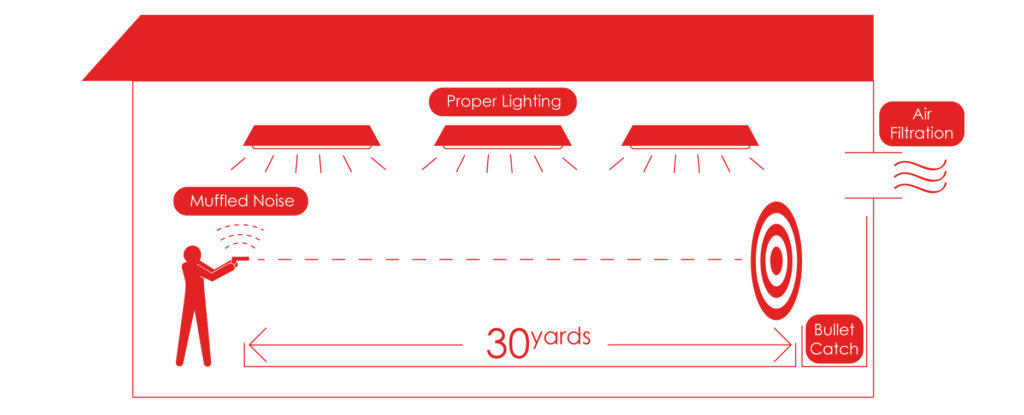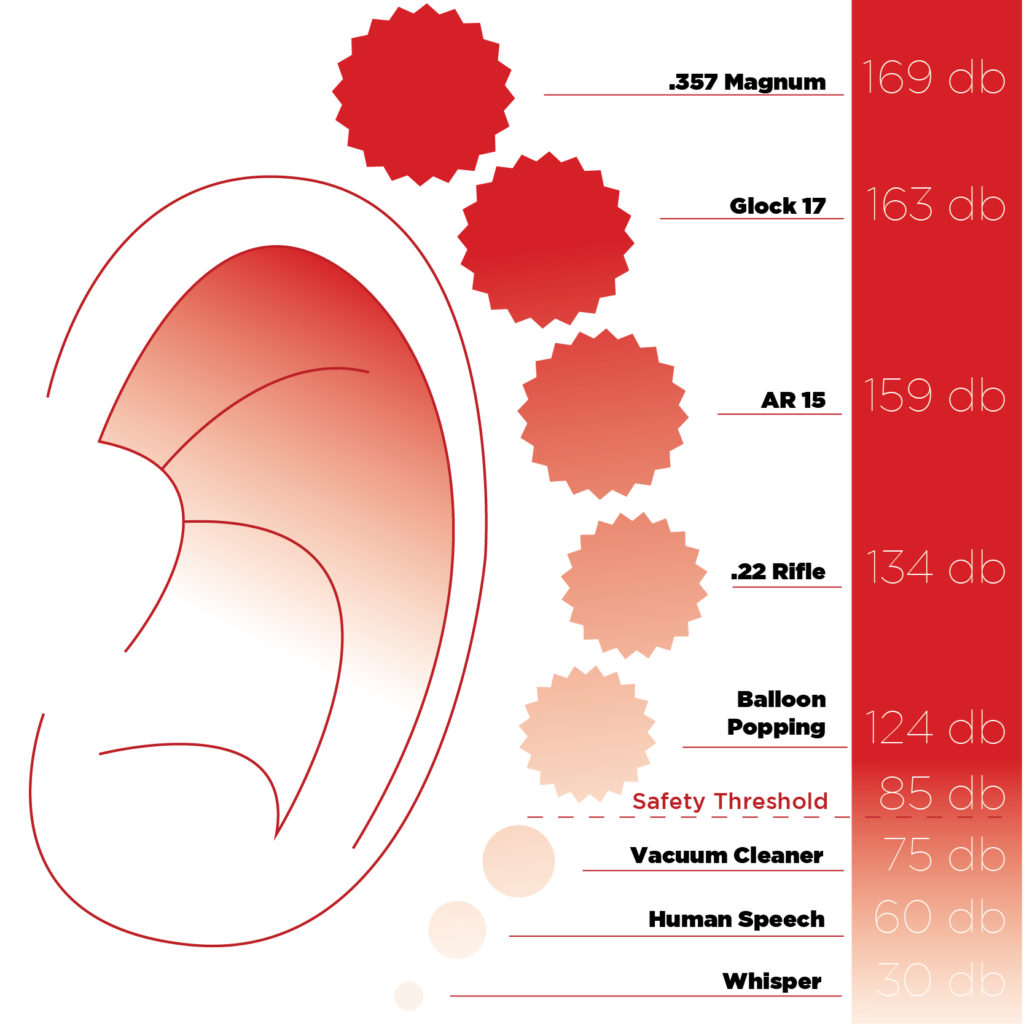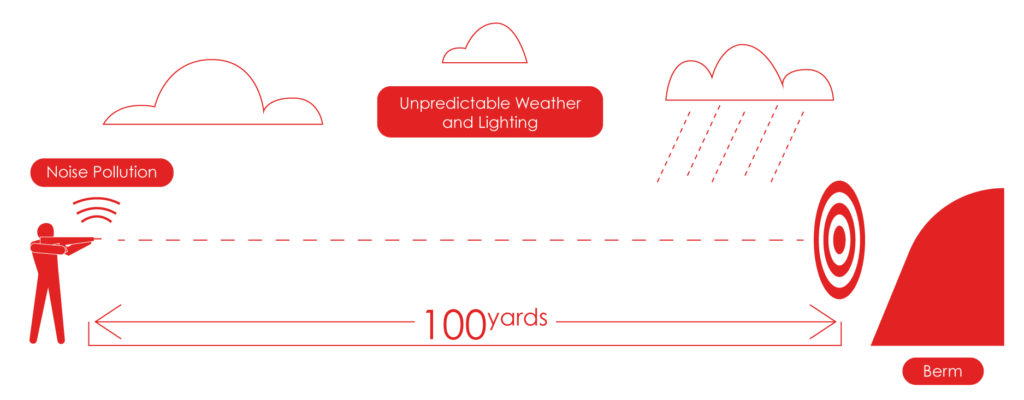First Steps
Create your business plan for the type of range you wish to open. There are two types of ranges, outdoor and indoor. Both have their own set of challenges and benefits. The type of range may also be affected by zoning requirements, since there are different requirements for each type.
Indoor Gun Ranges:
As the name suggests, indoor ranges are inside a building and can be built or located anywhere zoning laws allow. The benefits of indoor ranges are:
- Can be located near high traffic areas
- Facilitates lead maintenance
- Noise is easier to control
- Add a profit-enhancing pro shop
- Shooters can practice in any weather

Safety and Environmental Concerns with Indoor Ranges
When considering some safety and environmental concerns associated with gun ranges, indoor ranges offer a few advantages. Ranges are subject to many safety requirements, including noise pollution and safety, and it’s often easier for indoor ranges to meet these requirements as compared with outdoor ranges.
Noise within the range is still a risk to the health and safety of your customers and employees. To limit hearing damage, you can offer your customers the ability to rent gear to protect their ears. This rentable safety gear could be ear mufflers or earplugs, or even special hearing aids to block out the blast of firing a round.
Besides the safety of your customers, you have to consider the safety of those in the community. This is where noise pollution comes into play. Your range might be near apartment buildings or shopping centers, where people nearby aren’t shooting but are still affected by the noise. Depending on how close they are to the range, blasts from shooting could damage these individuals’ hearing. In addition, the ‘noise pollution’ of gunshots from the range may disturb people in their homes and cause them to complain.
An indoor range can contain most of the noise from shooting. The gun shot noise stays within the building, making noise safety for your customers and employees your only concern. Refer to the diagram below for information about safe sound levels:

Another safety issue is lead contamination. There are very strict guidelines from the EPA and OSHA regarding lead safety, which ranges must obey. Failure to comply can result in closure and fines. An indoor range offers more safety and is more environmentally friendly with regards to lead, because spent bullets stay inside the range and the indoor range has more options for containment of bullets and their lead dust. It’s easier to manage lead distribution in an indoor range as compared to outdoor gun ranges, especially when you use bullet traps.
The disadvantages to indoor ranges:
- Ventilation requirements
- Limited space
- Line shooting only (typically)
- Gun restrictions
- Zoning restrictions
Indoor ranges must have a high-quality HVAC system with air filters to keep shooters and employees safe. The system provides ventilation to keep the range from getting too smoky while the filter collects harmful lead particles and prevents them from escaping and contaminating the air. These systems are critical for preventing lead poisoning in shooters and employees.
Indoor range owners must also invest in noise reduction, since they are often located in the surrounding area of other businesses. Foam, sealants, special doors, and other applications lead to added construction costs.
Another issue with indoor ranges is space limitation. Shooters can only shoot at the line, unless the range has added costly indoor courses. Recreational indoor ranges aren’t suitable for field training for special forces or military personnel. Adding an indoor shooting course would drive up costs for a bigger building.
Due to space and closeness of other shooters on the line, there are gun restrictions. Shooters can typically only use pistols and single-shot firearms.
Outdoor Gun Ranges
Outdoor ranges can be set in a variety of open-air (covered or uncovered) natural setting, which some shooters prefer due to the more realistic setting and larger grounds. The benefits of outdoor ranges are:
- More mobility
- Multiple stations
- Realistic scenarios
- Reduced cost to build
Outdoor ranges provide more mobility than indoor ranges. Since the range isn’t contained to a single building, shooters can move more freely between different areas of the shooting course.
With increased space, outdoor ranges can have multiple stations. In this way, shooters aren’t limited to shooting in a line and have more variety. Gun range owners can get more creative with the different shooting stations, with fun themes and decorations to enhance the experience. An outdoor range can take the simple hobby of shooting from the basic line, and offer something far more engaging, creating a golf course style gun range or even something as elaborate as an adventure park style gun range.
Outdoor ranges are also capable of presenting more realistic scenarios to their guests. Targets can be placed in areas covering the span of the range, at varying distances to bring more of a challenge. In addition, vehicles can go from station to station, a tactic used in military training.
Finally, outdoor ranges are usually less expensive to build. Construction is expensive in itself, requiring a lot of time, money and materials without the special needs of indoor ranges. Outdoor ranges don’t require a building, nor costly HVAC systems and filters.
Environmental and Safety Concerns with Outdoor Ranges
While outdoor ranges offer flexibility and variety, they do present some environmental and safety challenges.
An outdoor range’s greatest safety challenge is noise. Since the range is out in the open, it is more difficult to control the loud sounds from gunshots. People outside of the range can get irritated from the sound of gunshots if they are in hearing range. If an outdoor range is too close to a residential area, they may get a lot of noise/nuisance complaints from residents. Outdoor ranges typically can only be open from sunrise to sunset, under USDA regulation.
Other factors besides noise can hurt non-shooters. Most importantly, lead contamination is the major environmental threat with outdoor ranges. Lead is not water soluble, and can pollute water if the two elements come into contact. It can reach water from rain runoff of contaminated soil, so it’s critical that outdoor ranges are far from water sources. Lead contamination impacts wildlife too; animals can get sick from eating contaminated grasses.
Without proper care to contain lead particles from fired bullets, there is a serious risk of damage to the environment and natural ecosystems of wildlife. The possible consequences on the community and wildlife can make outdoor ranges less environmentally friendly and therefore, less optimal in some cases.
The disadvantages of outdoor ranges are:
- Greater difficulty of bullet containment
- Soil/water lead contamination
- Remote/rural location requirement
- Less convenient location for shooters

Since outdoor ranges often cover huge plots of land, there’s more ground to cover for cleanup of used bullets. Shooters can also use multiple stations, and even sometimes shoot from moving vehicles as part of tactical training. These combined factors make bullet containment difficult for an outdoor gun range. However, the appropriate recovery and disposal of used bullets is incredibly important, due to the presence of lead dust and residue that will contaminate the soil and water if left behind.
Soil and water contamination is a serious issue, and a disadvantage for outdoor ranges. These ranges must follow the Resource Conservation and Recovery Act (RCRA) laws, under which lead is considered hazardous waste.
Gun ranges have to register as generators of hazardous waste, but they are under contract. Owners are responsible for the safe and correct disposal of lead, including the use of lead reclamation services. These services allow owners to safely store lead until pick-up. Gun ranges must keep records of pick up and storage of spent lead bullets.
Outdoor ranges near bodies of water must follow RCRA as well as the Clean Water Act. To avoid violations, ranges can operate away from water or make sure it’s not near the line of fire.
If an outdoor range becomes more of a threat to the community and environment for failing to follow RCRA and CWA regulations, the EPA, government, or citizens can sue. Gun ranges can face a lawsuit whether they are open for business or not, so owners must be careful.
A business obstacle of outdoor gun ranges is the requirement that they be remote. Since they are outside and require a lot of space for loud activities, they must be located away from towns and cities. Outdoor gun ranges are almost always in rural and remote locations in order to follow the laws for noise. Unfortunately for gun range owners, this may create a barrier for some customers who are unable to travel outside of their town or city to go shooting. The remoteness of outdoor ranges limits their customer base. Shooters have to travel longer and to further distances, which may be less appealing.
